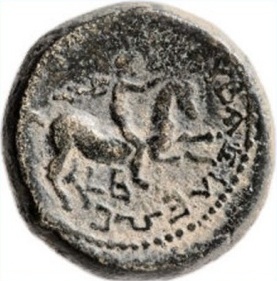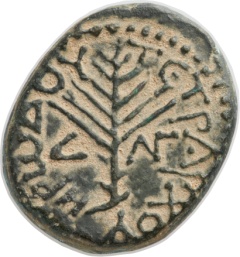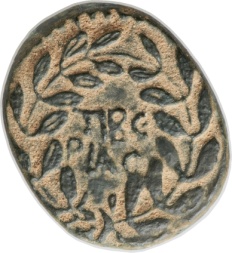The most common coin of Agrippa was also the only coin issued for circulation in his Jewish territories. This bronze prutah shows a royal umbrella on the obverse surrounded by the Greek inscription "King Agrippa;" the reverse features three ears of barley and the date "LS" (Year 6 = 42/43 CE). (#35)

#35 - Common bronze prutah of Herod Agrippa I (H-1244)
All of his other coins of Herod Agrippa I contain graven images - portraits of the Emperor or even the Jewish ruler himself. One great rarity features a portrait of Agrippa along with his son Agrippa II on horseback. (#36)


#36 - Coin of Herod Agrippa I, reverse inscribed Year 2 = 38 CE (H-1237)
Other grandchildren and relatives of Herod the Great ruled over pagan areas by the will of Imperial Rome. One descendent, Tigranes, was a King of Armenia, and another Herod received the throne of Chalcis (ancient Syria). Herod of Chalcis (41-48 CE) was also guardian of the Jewish Temple in Jerusalem, and appointed the High Priest. Both Herod of Chalcis and his son Aristobulus of Chalcis (57-92 CE) felt no need to heed the Jewish prohibition of portraits on the coins issued for their pagan territories, and so their likenesses appeared. One particular rarity features a portrait of Aristobulus' infamous wife - Salome -- daughter of Herod Philip. "When Herod's birthday was kept, the daughter (Salome) of Herodias danced before them, and pleased Herod (Antipas)" (Matthew 14:6). (#37)

#37 - Coin features portraits of Aristobulus of Chalcis and his wife Salome (H-1255)
The last ruler of the Herodian line - Agrippa II - reigned for an impressive 43 years (50-96 CE). This is the "Agrippa (who) said unto Paul, almost thou persuades me to be a Christian" (Acts 26:28). Coins issued by Agrippa II include both Jewish (#38) and pagan (#39) types.


#38 - Coin of Agrippa II, struck in Tiberias in 53 CE, features palm branch (H-1266)

#39 --Coin of Agrippa II (86 CE) features portrait of Emperor Vespasian and a Roman goddess (H-1282)
© 2020-Mel Wacks